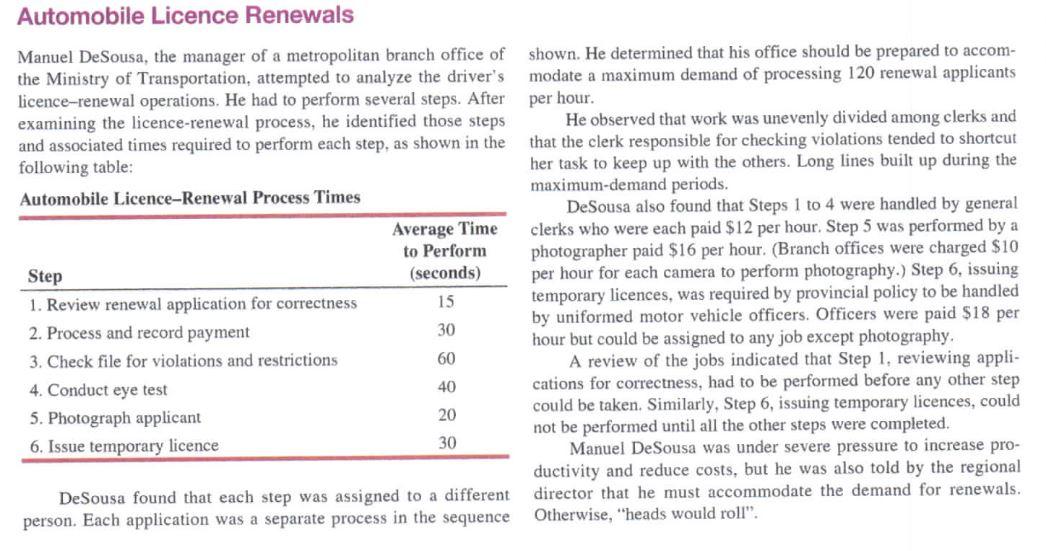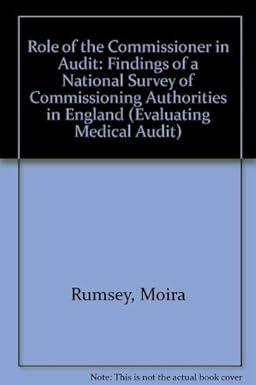Answered step by step
Verified Expert Solution
Question
1 Approved Answer
Marking scheme: 5 marks for question 1 (2 for answer, 3 for explanation) Question 2, same as question 1. Question 3, 10 marks total, 2
 Marking scheme: 5 marks for question 1 (2 for answer, 3 for explanation)
Marking scheme: 5 marks for question 1 (2 for answer, 3 for explanation)
Question 2, same as question 1.
Question 3, 10 marks total, 2 for answer, 3 for explanation, 5 for new configuration.
Question 4, 10 marks total, 5 marks for new configuration, 2 for cost per application, 3 for proof/explanation of how you got that answer.
Total 30 marks.
Questions:
- What is the maximum number of applications per hour that can be handled by the present configuration of the process?
- How many applications can be processed per hour if a second clerk is added to check for violations?
- If the second clerk could be added anywhere you choose (not necessarily where you added him or her in Question 2), what is the maximum number of applications per hour? What is the new configuration?
How would you suggest modifying the process to accommodate 120 applications per hour? What is the cost per application of this new configuration
Automobile Licence Renewals shown. He determined that his office should be prepared to accom- modate a maximum demand of processing 120 renewal applicants per hour. Manuel De Sousa, the manager of a metropolitan branch office of the Ministry of Transportation, attempted to analyze the driver's licence-renewal operations. He had to perform several steps. After examining the licence-renewal process, he identified those steps and associated times required to perform each step, as shown in the following table: Automobile Licence-Renewal Process Times Average Time to Perform Step (seconds) 1. Review renewal application for correctness 15 2. Process and record payment 30 3. Check file for violations and restrictions 60 4. Conduct eye test 40 5. Photograph applicant 20 6. Issue temporary licence 30 He observed that work was unevenly divided among clerks and that the clerk responsible for checking violations tended to shortcut her task to keep up with the others. Long lines built up during the maximum-demand periods. DeSousa also found that Steps 1 to 4 were handled by general clerks who were each paid $12 per hour. Step 5 was performed by a photographer paid $16 per hour. (Branch offices were charged $10 per hour for each camera to perform photography.) Step 6, issuing temporary licences, was required by provincial policy to be handled by uniformed motor vehicle officers. Officers were paid $18 per hour but could be assigned to any job except photography, A review of the jobs indicated that Step 1, reviewing appli- cations for correctness, had to be performed before any other step could be taken. Similarly, Step 6, issuing temporary licences, could not be performed until all the other steps were completed. Manuel De Sousa was under severe pressure to increase pro- ductivity and reduce costs, but he was also told by the regional director that he must accommodate the demand for renewals. Otherwise, "heads would roll". DeSousa found that each step was assigned to a different person. Each application was a separate process in the sequence Automobile Licence Renewals shown. He determined that his office should be prepared to accom- modate a maximum demand of processing 120 renewal applicants per hour. Manuel De Sousa, the manager of a metropolitan branch office of the Ministry of Transportation, attempted to analyze the driver's licence-renewal operations. He had to perform several steps. After examining the licence-renewal process, he identified those steps and associated times required to perform each step, as shown in the following table: Automobile Licence-Renewal Process Times Average Time to Perform Step (seconds) 1. Review renewal application for correctness 15 2. Process and record payment 30 3. Check file for violations and restrictions 60 4. Conduct eye test 40 5. Photograph applicant 20 6. Issue temporary licence 30 He observed that work was unevenly divided among clerks and that the clerk responsible for checking violations tended to shortcut her task to keep up with the others. Long lines built up during the maximum-demand periods. DeSousa also found that Steps 1 to 4 were handled by general clerks who were each paid $12 per hour. Step 5 was performed by a photographer paid $16 per hour. (Branch offices were charged $10 per hour for each camera to perform photography.) Step 6, issuing temporary licences, was required by provincial policy to be handled by uniformed motor vehicle officers. Officers were paid $18 per hour but could be assigned to any job except photography, A review of the jobs indicated that Step 1, reviewing appli- cations for correctness, had to be performed before any other step could be taken. Similarly, Step 6, issuing temporary licences, could not be performed until all the other steps were completed. Manuel De Sousa was under severe pressure to increase pro- ductivity and reduce costs, but he was also told by the regional director that he must accommodate the demand for renewals. Otherwise, "heads would roll". DeSousa found that each step was assigned to a different person. Each application was a separate process in the sequenceStep by Step Solution
There are 3 Steps involved in it
Step: 1

Get Instant Access to Expert-Tailored Solutions
See step-by-step solutions with expert insights and AI powered tools for academic success
Step: 2

Step: 3

Ace Your Homework with AI
Get the answers you need in no time with our AI-driven, step-by-step assistance
Get Started


